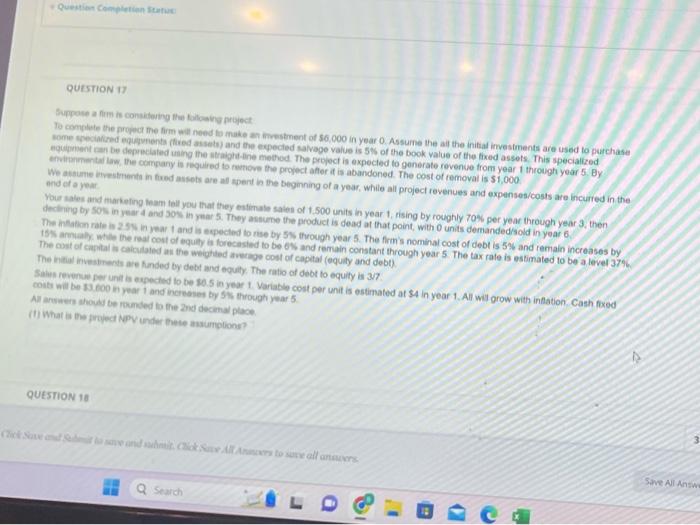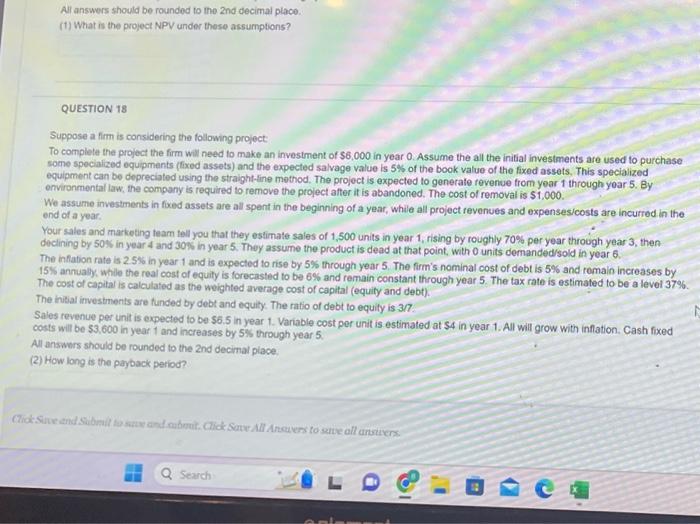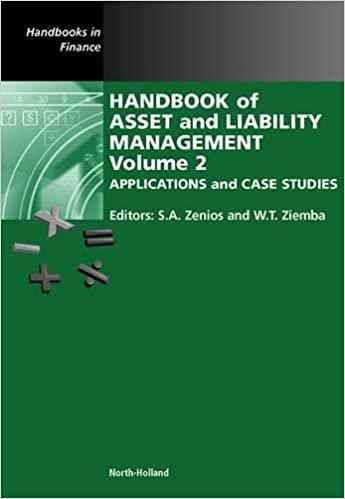forpose a firm is consitwing Ela falloang prisiect. To complaie the propeg me firm will need to make an firestment of $6,000 in year 0 . Assurne the alf the initiad imvesiments are used to purchase Bome spesiafired equidrienta (fied assets) and the expecied salvage vaive is 5% of the book value of the fixed assets. This specialized We asaume etrestmenta in fued assets are at spert in the peconnither it is abandoned. The cost of removal is 51,000 and of a year decleing by sols in-rest. ists armially. while the reat cost of equily ia forecasted to be 6 , and and yegear 5 . The firm s nominal cost of debt is 5%6 and remain increases by? The initial investrents are fanded by debt and equily. The ratio of debt to equity and debt) coats ail be 13.600 mi year 1 and increases by 5 th through year 5 - per unit is ostimated at 54 in year 1. All wul grow with inflation. Cash fxod All arwieis shoid be risuled to the 2 hel decenal place. (1) What io the fropect Npy under the te asumptions? QUESTION 18 All answers should be rounded to the 2nd decimal place. (1) What is the project NPV under these assumptions? QUESTION 18 Suppose a firm is considering the following project To complete the project the firm will need to make an investment of $6,000 in year 0 . Assume the all the initial investments are used to purchase some specialized equipments (fixed assets) and the expected salvage value is 5% of the book value of the fixed assets. This specialized equipment can be depreciated using the straight-line method. The project is expected to generate revenue from yoar 1 through yoar 5 . By environmental law, the company is required to remove the project after it is abandoned. The cost of removal is $1,000. We assume investments in fixed assets are all spent in the beginning of a year, while all project revenues and expensesicosis are incurred in the end of a year. Your sales and marketing team tell you that they estimate sales of 1,500 units in year 1 , rising by roughly 70% per year through year 3 , then declining by 50% in year 4 and 30% in year 5 . They assume the product is dead at that point, with 0 units demanded/sold in year 6 . The infation rate is 2.5% in year 1 and is expected to rise by 5% through year 5 . The firm's nominal cost of debt is 5% and romain increases by 15% annualy. whlle the real cost of equity is forecasted to be 6% and remain constant through year 5 . The tax rate is estimated to be a level 37%. The cost of capital is calculated as the weighted average cost of capital (equity and debt). The initial investments are funded by debt and equity. The ratio of debt to equity is 3/7. Sales revenue per unit is expected to be $6.5 in year 1 . Variable cost per unit is estimated at $4 in year 1 . All will grow with inflation. Cash fixed costs will be $3,600 in year 1 and increases by 5% through year 5 . All answers should be rounded to the and decinal place. (2) How long is the payback period? Suppose a fim is considering the following propect To complete the project the fim will need to make an investment or $6,000 in yoar 0 . Assume the all the initial investments are used to purchase come apecial ined equipenents (fred assets) and the expected salvage value is 5% of the book value of the fixed assets. This specialized eguipment can be deprecialed using the straight-line method. The project is expected to generate revenue from year 1 through year 5 . By environmental law. the company is required to remove the project after it is abandoned. The cost of removal is $1,000. We ansume investments in fired assets are alf spent in the beginning of a year, whilo all project revenues and expenses/costs are incurred in the and of a year. Your saies and marketing team tell you that they estimate sales of 1,500 units in year 1, rising by roughly 7056 per year through year 3 , then declining by 50N in year 4 and 30s in year 5, They assume the product is dead at that point, with 0 units demanded/sold in year 6. The inlation rate is 2.5w in year 1 and is expected to rise by 5% through year 5 . The firm's nominal cost of debt is 5% and remtain increases by 155 annualy, while the real cost of equity is forecasted to be 6% and remain constant through year 5 . The tax rate is estimated to be a level 37%. The cast of caplai is calculated as the weighted average cost of capital (equity and debt). The heial hvestments are funded by debt and equity, The ratio of debt to equity is 3/7 Sales revenue per unit is expected to be $8.5 in year 1 . Variable cost per unit is estimated at $4 in year 1 . All will grow with inflation. Cash fixed conts will be $9,600 in year 1 and increases by 5 st through yoar 5. AS answers should be rounded to the znd decimal place. (3) How long is the dincounted payback period? forpose a firm is consitwing Ela falloang prisiect. To complaie the propeg me firm will need to make an firestment of $6,000 in year 0 . Assurne the alf the initiad imvesiments are used to purchase Bome spesiafired equidrienta (fied assets) and the expecied salvage vaive is 5% of the book value of the fixed assets. This specialized We asaume etrestmenta in fued assets are at spert in the peconnither it is abandoned. The cost of removal is 51,000 and of a year decleing by sols in-rest. ists armially. while the reat cost of equily ia forecasted to be 6 , and and yegear 5 . The firm s nominal cost of debt is 5%6 and remain increases by? The initial investrents are fanded by debt and equily. The ratio of debt to equity and debt) coats ail be 13.600 mi year 1 and increases by 5 th through year 5 - per unit is ostimated at 54 in year 1. All wul grow with inflation. Cash fxod All arwieis shoid be risuled to the 2 hel decenal place. (1) What io the fropect Npy under the te asumptions? QUESTION 18 All answers should be rounded to the 2nd decimal place. (1) What is the project NPV under these assumptions? QUESTION 18 Suppose a firm is considering the following project To complete the project the firm will need to make an investment of $6,000 in year 0 . Assume the all the initial investments are used to purchase some specialized equipments (fixed assets) and the expected salvage value is 5% of the book value of the fixed assets. This specialized equipment can be depreciated using the straight-line method. The project is expected to generate revenue from yoar 1 through yoar 5 . By environmental law, the company is required to remove the project after it is abandoned. The cost of removal is $1,000. We assume investments in fixed assets are all spent in the beginning of a year, while all project revenues and expensesicosis are incurred in the end of a year. Your sales and marketing team tell you that they estimate sales of 1,500 units in year 1 , rising by roughly 70% per year through year 3 , then declining by 50% in year 4 and 30% in year 5 . They assume the product is dead at that point, with 0 units demanded/sold in year 6 . The infation rate is 2.5% in year 1 and is expected to rise by 5% through year 5 . The firm's nominal cost of debt is 5% and romain increases by 15% annualy. whlle the real cost of equity is forecasted to be 6% and remain constant through year 5 . The tax rate is estimated to be a level 37%. The cost of capital is calculated as the weighted average cost of capital (equity and debt). The initial investments are funded by debt and equity. The ratio of debt to equity is 3/7. Sales revenue per unit is expected to be $6.5 in year 1 . Variable cost per unit is estimated at $4 in year 1 . All will grow with inflation. Cash fixed costs will be $3,600 in year 1 and increases by 5% through year 5 . All answers should be rounded to the and decinal place. (2) How long is the payback period? Suppose a fim is considering the following propect To complete the project the fim will need to make an investment or $6,000 in yoar 0 . Assume the all the initial investments are used to purchase come apecial ined equipenents (fred assets) and the expected salvage value is 5% of the book value of the fixed assets. This specialized eguipment can be deprecialed using the straight-line method. The project is expected to generate revenue from year 1 through year 5 . By environmental law. the company is required to remove the project after it is abandoned. The cost of removal is $1,000. We ansume investments in fired assets are alf spent in the beginning of a year, whilo all project revenues and expenses/costs are incurred in the and of a year. Your saies and marketing team tell you that they estimate sales of 1,500 units in year 1, rising by roughly 7056 per year through year 3 , then declining by 50N in year 4 and 30s in year 5, They assume the product is dead at that point, with 0 units demanded/sold in year 6. The inlation rate is 2.5w in year 1 and is expected to rise by 5% through year 5 . The firm's nominal cost of debt is 5% and remtain increases by 155 annualy, while the real cost of equity is forecasted to be 6% and remain constant through year 5 . The tax rate is estimated to be a level 37%. The cast of caplai is calculated as the weighted average cost of capital (equity and debt). The heial hvestments are funded by debt and equity, The ratio of debt to equity is 3/7 Sales revenue per unit is expected to be $8.5 in year 1 . Variable cost per unit is estimated at $4 in year 1 . All will grow with inflation. Cash fixed conts will be $9,600 in year 1 and increases by 5 st through yoar 5. AS answers should be rounded to the znd decimal place. (3) How long is the dincounted payback period









